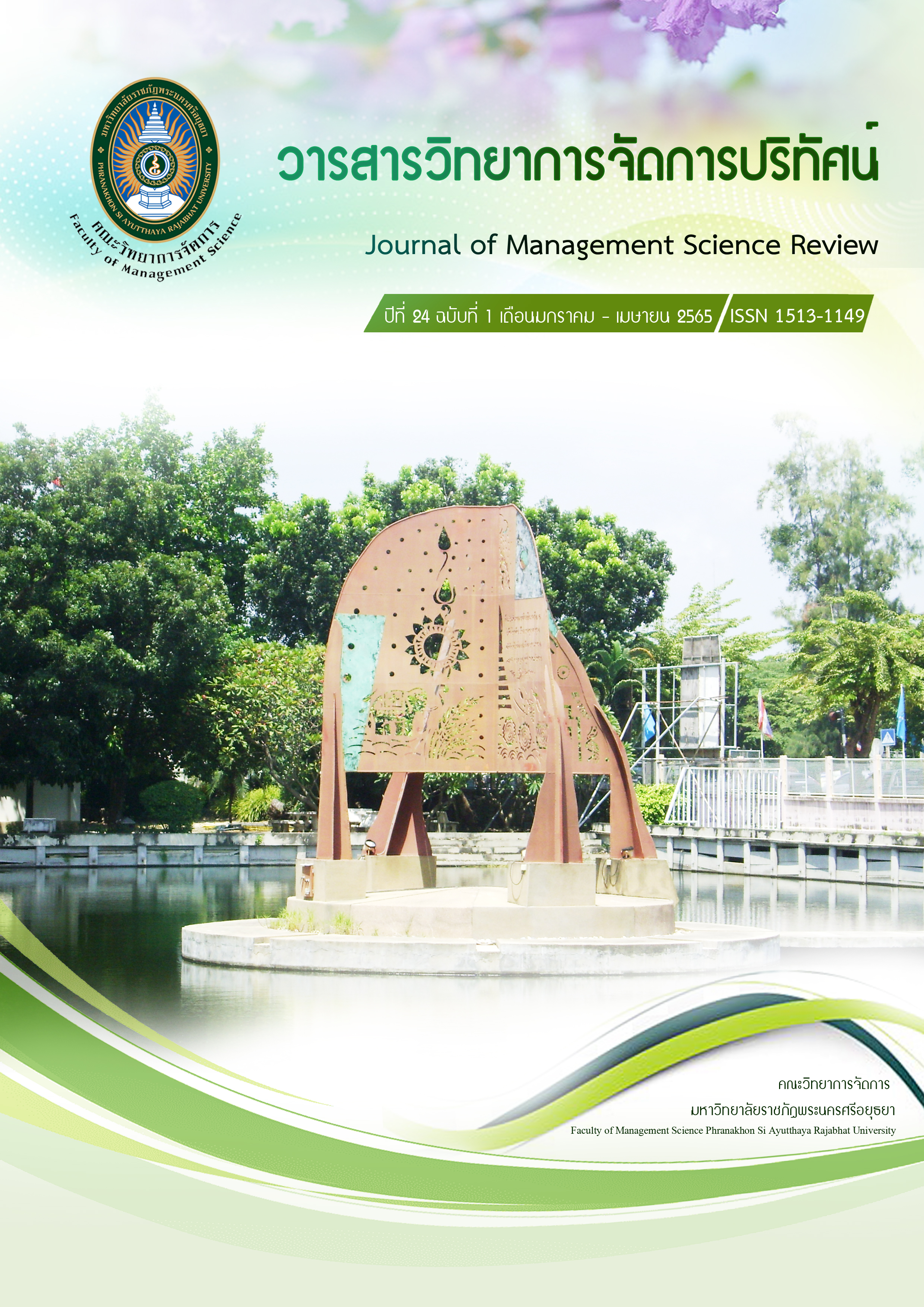Modern Leadership Development Model in Thai Logistics Service Organizations
Keywords:
Modern Leadership Development Models, Business Organization, Thai Logistics Service OrganizationAbstract
The objectives of this study were 1) to study the general characteristics of the target population and the level of importance of factors contributing to modern leadership, 2) to develop a modern leadership model by quantitative research using exploratory component analysis techniques, corroborative component analysis, and structural equation model analysis, and 3) to examine the practical suitability of modern leadership models created by qualitative research with in-depth interview techniques. A mixed method was employed as a research methodology. The sample consisted of 600 organizations for quantitative research and 3 experts in strategic business administration for qualitative research. The results showed that 1) the general population characteristics revealed that most logistics service organizations are medium-sized enterprises (51.50%), operating in the form of land transport business (52.20%), establishing a business period 5 years-10 years (44.80%), annual income less than 100 million baht (69.20%), and establishments in the Bangkok area (21.80%), the data on the level of importance of factors contributing to modern leadership found that the majority of respondents were on average for factors contributing to modern leadership as a whole in the high level (= 3.529-3.670; SD=.543-.645). 2) The development of the modern leadership style found that (1) the survey component analysis revealed that the three components could describe all variables 55.659%, significantly at .05 (p-value<.05), (2) the results of the confirmation component analysis found that the results of the structural validity verification of the teaching-task component measurement model, the challenge-building component measurement model, and the confidence-building component measurement model were structural consistent and harmonious with the empirical data, and (3) the results of a straightness analysis of the structural equation model of success in modern leadership development revealed that the Chi-square value was 73.084, df=72 and p-value=.442>.050 index value RMSEA=.004<.080, CFI=1.000>.950 and c2/df=1.015<2 which showed that the modern leadership development success model is harmonious with the data. Empirical factor loading of observed variables for all latent variables was positive and differed from zero at statistically significant levels. 05. It was also found that job coaching, challenging, and ensuring direct, indirect, and collective influences on success in the development of modern leadership, and 3) the results of an examination of the practical suitability of the created model found that the 3 experts agreed that the modern leadership development model in the Thai logistics service organization are accurate components, suitable for implementation, and significantly useful.
References
กรมพัฒนาธุรกิจการค้า. (2562). ธุรกิจโลจิสติกส์ไทย...ถึงเวลาต้องปรับตัวเปลี่ยนวิธีคิด นำเทคโนโลยีช่วยบริหารจัดการ.. เปลี่ยนคู่แข่งเป็นพันธมิตร. กรุงเทพฯ : ผู้แต่ง.
สุดแท้. (2553). การพัฒนารูปแบบการบริหาร งานวิชาการสำหรับโรงเรียนขนาดเล็ก. วิทยานิพนธ์ครุศาสตรดุษฎีบัณฑิต สาขาวิชาการบริหารการจัดการศึกษา, มหาวิทยาลัยมหาสารคราม.
ชิรวัฒน์ นิจเนตร. (2560). การวิจัยพัฒนารูปแบบทางสังคมศาสตร์และการศึกษา. วารสารราชภัฏสุราฎร์ธานี. 4(2). 71-102.
ธราธร รัตนนฤมิตศร. (2564, 9 มิถุนายน). Impact Canada กลยุทธ์สร้างนวัตกรรมจากปัญญามหาชน. กรุงเทพธุรกิจ. จากhttps://www.bangkokbiznews.com/blogs/columnist/127568
ปัญญา ทองนิล. (2553). รูปแบบการพัฒนาสมรรถภาพการสอนโดยการบูรณาการแบบสอดแทรกสำหรับนักศึกษาครู เพื่อเสริมสร้างคุณลักษณะอันพึงประสงค์ของผู้เรียน. กรุงเทพฯ : มหาวิทยาลัยศิลปากร.
พสุ เดชะรินทร์. (2556). ภาวะผู้นำกับการพัฒนากลยุทธ์ในการจัดการเปลี่ยนแปลง. ม.ป.ท.
มัลลิกา ต้นสอน. (2544). พฤติกรรมองค์การ. กรุงเทพฯ: ด่านสุทธาการพิมพ์.
รังสรรค์ ประเสริฐศรี. (2544). ภาวะผู้นำ Leadership). กรุงเทพฯ: ธนธัชการพิมพ์.
รัตนะ บัวสนธ์. (2556). วิธีการเชิงผสมผสานสำหรับการวิจัยและประเมิน. กรุงเทพฯ: จุฬาลงกรณ์มหาวิทยาลัย.
วาโร เพ็งสวัสดิ์. (2553). การวิจัยพัฒนารูปแบบ. วารสารมหาวิทาลัยราชภัฏสกลนคร, 2(4), 1-15.
วรวรรษ เทียมสุวรรณ, วัชรพล วิบูลยศริน, ศิโรจน์ ผลพันธิน และเหม ทองชัย . (2562, พฤษภาคม - สิงหาคม). ภาวะผู้นำเชิงกลยุทธ์ในศตวรรษที่ 21. วารสารวิชาการบัณฑิตวิทยาลัยสวนดุสิต, 15(2). 219-231.
สุชาติ ประสิทธิ์รัฐสินธุ์. (2544). ระเบียบวิธีการวิจัยทางสังคมศาสตร์. กรุงเทพฯ : เฟื่องฟ้าพริ้นติ้ง.
สถาบันเพิ่มผลผลิตแห่งชาติ. (2552). TQA (Thailand Quality Award). กรุงเทพฯ : ผู้แต่ง.
AHSC. (1985). The American Heritage Dictionary of the English Language. (3 rd ed.). Boston: Houghton Mifflin.
Conger J.A., and Kanungo R.N. (1987). Toward a Behavioral Theory of Charismatic Leadership in Organizational Settings. Academy of Management Review, 12, 637-647.
Den Hartog, D. N., House, R. J., Hanges, P. J., Ruiz-Quintanilla, S. A. and Dorfman, P. W. (1999). Culture specific and cross- culturally generalizable implicit leadership theories: Aer attributes of charismatic/transformational leadership universally endorsed? 1. Leadership Quarterly, 10(2), 219–256.
Bridges, F. (2017, 21 Jul). 10 Ways To Build Confidence. Retrieved from https://www.forbes.com/sites/francesbridges/2017/07/21/10-ways-to-build-confidence/?sh=604e29ba3c59
Greenacre, L., Tung, N.M. and Chapman, T. (2014) ‘Self Confidence and the Ability to Influence’. Academy of Marketing Studies Journal, 18(2), 169-180.
International Mentoring Group. (2020). Definition of coaching in 2020. Who is the coach and how he works nowadays. Retrieved from https://mentoringgroup.com/what-is-coaching.html
Koontz , H. and Weihrich . H. (1988). Management. New York : McGraw-Hill.
Kouzes, J. M., and Posner, B. Z. (1987). The Leadership Challenge: How to Get Extraordinary Things Done in Organizations. San Francisco: Jossey-Bass.
Larzelere, R.E. and Huston, T.L. (1980). The Dyadic Trust Scale: Toward Understanding Interpersonal Trust in Close Relationships. Journal of Marriage and the Family, (43), 595-604.
Madaus, G.F., Scriven, M.S. and Stufflebeam, D.L. (1983). Evaluation models. [electronic resource]. Viewpoints on educational and human services evaluation. Dordrecht: Springer Netherlands.
Mayer, R. C., Davis, J. H. and Schoorman, F. D. (1995). An Integrative Model of Organizational Trust. Academy of Management Review, 20, 709-724.
https://doi.org/10.5465/amr.1995.9508080335.
Mescon. M.K., Albert. M. and Khedori. F. (1985). Management. New York : Harper & Row
Mishra, A. K. (1996). Organizational responses to crisis : the centrality of trust. In Kramer, R. M. and Tyler, T. R. (eds). Trust In organizations : Frontiers of theory and research (pp. 261-287). Thounsand Oaks, CA : Sage.
Mitchell, T. R. and Larson, J. R. (1987). People in Organization: An Introduction to Organizational Behavior. (3 rd ed.). Singapore: McGraw-Hill.
Morgan, R. M. and Hunt, S. D. (1994). The Commitment - Trust Theory of Relationship Marketing. Journal of Marketing, 58 (July), 20-30.
Mpower A.S.C.E.R.T. Institute. (2020). Character builds confidence and furnishes success.
Passmore, J. (2016). Excellence in Coaching: The Industry Guide. (3rd ed.). n.p.: Kogan Page.
Quick MBA management. (2021). Quick MBA Knowledge to Power Your Business. Retrieved from http://www.quickmba.com/mgmt/leadership/3c/
Renton, J. (2009). Coaching and mentoring. what they are and how to make the most of them. New York: Bloomberg Press.
Rush, D. D. and Sheldon, M. L. (2016). Five Characteristics of Coaching. MAH Coaching Support.
Schwartz, Z.D. (1980). Introduction to Management: Principle, Practice and Process. New York: Harcourt Brace Jovanovich.
Stogdill, R. (1974). Handbook of leadership: A survey of theory and research. New York: The Free Press.
Thornton, P. B. (1999). Thornton’s 3-C Leadership Model. by Quick MBA Knowledge to Power Your Business.




